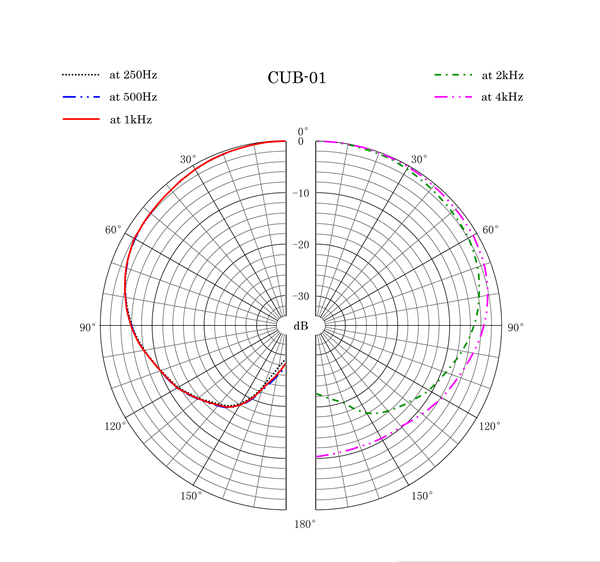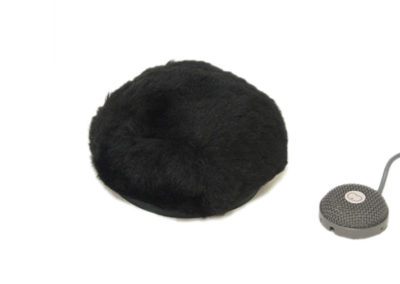CUB-01
MINIATURE
BOUNDARY
MIC
Miniature High Quality Cardioid Boundary Microphone
Offers a totally new design‐ a Sanken original ‐ which overcomes the limitations of previous boundary microphones, producing an extremely rich and full bodied sound in a much smaller package. Although very small (1.26″ diameter, .5″ tall), and weighing only 1.6oz., the sound is superior to much larger boundary types.
The CUB‐01 is designed for use in many situations like film and televison production on set or on location, in a conference room, or on a podium. Especially effective in an automobile, this microphone has become a favorite for production professionals.
Most boundary microphones have almost the same sound characteristics, heard as “thin,” “solid,” and “metallic.” Using Sanken’s advanced technology, the CUB-01 has resolved this problem with its unique square-shaped cardioid capsule. This proprietary design significantly enlarges the effective area of the diaphragm, resulting in a boundary microphone whose sound is rich and natural, with a flat response to 70Hz.
CUB-01 shown with XLR3 Phantom Connector


A Totally New Concept in Cardioid Boundary Microphones
With the CUB-01 it is now possible to capture a full bodied and clear sound. Narration and dialogue are clearly caught while excluding unnecessary background noise. Sanken’s revolutionary design has also eliminated the artificial need to overdesign the acoustic construction to create cardioid directivity.
Engineered for use in many situations, from TV and film field shooting to broadcast studio production and conference table recording, the CUB-01 departs from the common design of the boundary mic, which typically requires a large, heavy plate. By comparison, the CUB-01 is unbelievably small (32mm diameter, 12mm height, 45g weight) and light.
Because of its size, it is easy to conceal from the camera, and can be positioned in a variety of environments – for example, attached to the ceiling of a car with two-sided sticky tape. The CUB-01 is available in gray or beige and in two versions – the standard high performance CUB-01 which runs on 48 volt phantom and the CUB-01-PT (pigtail) version. The PT version will operate on 3 to 10 VDC for wireless applications.
- Clear and rich sound
- Small and easy to conceal unlike other boundary mics
- Wide 60Hz-16kHz frequency response
- Sound energy in the high frequencies is identical with the mid and lows
- Perfect for TV and film field shooting, broadcast studio production and conference table recording
- New Sanken design that overcomes the limitations of previous boundary microphones
- Available in Gray or Beige
- Available with XLR3 connector or Pigtail
Two Versions:
CUB-01 XLR3M
Miniature Cardioid Boundary Microphone, 48V Phantom(+/‐ 4V, 3.0meter cable, XLR3M connector, Beige[BE] or Gray[GY]
CUB-01-BE (Beige)
CUB-01-GY (Gray)
CUB-01-PT PIGTAIL
Miniature Cardioid Boundary Microphone, Pigtail Version, 3.0meter cable stripped and tinned for termination, Beige[BE] or Gray[GY]
CUB-01-PT-BE (Beige)
CUB-01-PT-GY (Gray)
Theory of Boundary Microphones and the Sanken Solution
There are at least two paths of sound waves from a sound source to a microphone. One is a direct route from the sound source (D1), while another is sound reflected off the floor between the sound source and the microphone (R1). Obviously, sound D1 reaches the microphone earlier than sound R1. As a result, sound waves through the R1 route have a “time delay.” The sound waves through D1 and the “delayed” sound wave (R1) will be combined at the microphone. In this case, the delay of mid and low frequencies will not be as affected because of the wavelength. In the case of high frequencies, the time delay between D1 and R1 is critical because of its short wave length. In the high frequency range, the time delay of two sound waves creates a cancellation between the two. This is known as “comb filtering.”
When we think about this phenomenon as rms sound energy, we can see energy in the high frequency range decreasing considerably when compared to the mid and low frequencies. As frequency increases, energy decreases.
When we place a microphone “on the floor,” with virtually no distance between the microphone transducer and the reflecting floor surface, most of the sound waves from the sound source to the microphone act as one direct route. Theoretically, there is no reflected route, and in this type of mic positioning, there is no time delay and, therefore, no comb filtering even in the high frequency range. This means that sound energy in the high frequencies is identical with the mid and lows. This is the basic theory of a boundary microphone.
SPECIFICATIONS
All specifications are measured on 500mm X 700mm (19.7″x27.6″) board, except frequency response. Frequency response is measured without board. (0°ON AXIS)
|
Model Name |
CUB-01 |
|
Transducer |
Back electret condenser |
|
Directivity |
Cardioid/front side of hemisphere |
|
Frequency response |
60Hz – 15kHz |
|
Sensitivity (at 1kHz) |
40mV(-28dB)/Pa ±2dB(0dB=1V/Pa) |
|
Equivalent noise level (A weighted) |
16dB(A-weighted) IEC 179 |
|
Max SPL |
122 dB SPL (THD 1%, 1kHz) |
|
Output impedance( 1kHz ) |
180 Ω (1kHz) |
|
Powering |
48V ±4V phantom (U.P.F) |
|
Current consumption |
2.2mA |
|
Weight |
45g (1.6oz) (microphone) |
|
Dimensions |
Microphone; D: 32.5mm, H: 14mm (1.3″x0.55″) |
|
Surface finish |
Metal Mesh – woven wire cloth |
|
Connector |
XLR3-12C equivalent (1;G, 2;hot, 3;cold) |
CUB-01-PT SPECIFICATIONS:
All specifications except the following are the same as (or identical with) CUB-01. Only differing specs are listed.
|
Model Name |
CUB-01-PT Pigtail |
|
Sensitivity (at 1kHz) |
3V power supplied: 15mV(-36.5dB±2dB)/Pa (0dB=1V/Pa) |
|
Equivalent noise level (A weighted) |
(at 3V): 17dB(A-weighted) IEC 179 |
|
Max SPL |
3V power supplied: 121 dB SPL (THD 1%, 1kHz) |
|
Output impedance( 1kHz ) |
120Ω (1kHz), expected receive side impedance 5k Ω |
|
Powering |
3V to 14V(MAX) DC |
|
Current consumption |
3V power supplied: 0.6mA |
|
Connector |
Pig-tail: Cable direct out; |
|
Dimensions |
Microphone; D: 32.5mm, H: 14mm (1.3″x0.55″) |
POLAR PATTERN


FREQUENCY RESPONSE


ACCESSORIES
Included Accessories:
Optional Accessories
BBI-CUB-01
Windscreen for Sanken CUB‐01 Boundary Microphone. Two colors Black [BK], Gray [GY]. BBI-CUB-01-BK, BBI-CUB-01-GY





